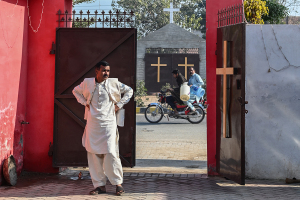Rare Medieval Bible Lost During Reformation Era Returns to Canterbury Cathedral

After almost 500 years, a rare medieval Bible has returned to the library at Canterbury Cathedral and will soon be displayed in exhibition.
The Lyghfield Bible, which is from the 13th century and is named after a monk who was once its owner, is reportedly one of the few books that survived intact when Canterbury Cathedral was broken apart during the Reformation era.
To acquire the Bible, Canterbury Cathedral received a grant of 96,000 pounds (nearly $126,000) from the National Heritage Memorial Fund and raised additional funds to purchase it from a private collector at a recent rare books sale in London.
The 13th century Bible was among the 30,000 books that were scattered after King Henry VIII broke up the monastic community at the cathedral in the 16th century. Today, it is one of only 30 books to have survived from the original collection. The Lyghfield Bible is said to be the finest ones to have survived, though how it survived is not known. The volume is written on 690 pages of fine parchment and contains beautiful illustrations throughout.
"It is of the utmost significance to us to have here in our collections a copy of the core Christian text which was owned by one of the last monks of the medieval monastic community," said Cressida Williams, head of the cathedral archives.
"The Bible bears witness to the upheavals of the Reformation, a time which defined what the cathedral is today, and will have a key role in telling visitors our story."
NHMF Chairman Sir Peter Luff said his organization's trustees agreed that it was imperative for the nation to preserve the book.
"Not only an incredibly rare book directly linked to one the most turbulent periods of British history, the Lyghfield Bible is also exquisitely beautiful," he said.
The Bible will soon be placed in a new exhibition area of the cathedral and is now part of a collection which is inscribed on the UNESCO UK Memory of the World Register.
Canterbury Cathedral also holds historic records of the cathedral that date back to the 9th century and houses 20 Anglo-Saxon charters, which date from before the Norman Conquest of 1066.
"Taken together, these are the Cathedral's oldest possessions, which predate any of the buildings seen standing today," its website notes.





























